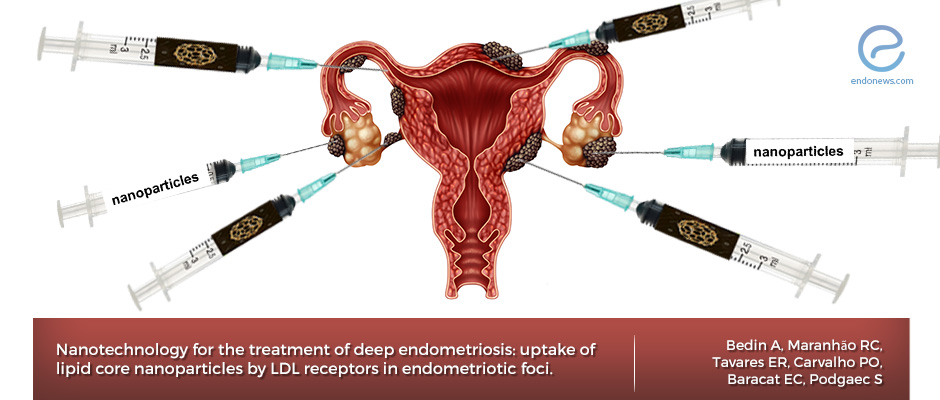Nanotechnology as a tool for targeted therapy of endometriosis
Aug 9, 2019
Can nanoparticle technology be utilized to specifically target proliferating endometriotic cells for future medical therapy?
Key Points
Highlights:
- Use of nanotechnology as a tool for targeted therapy of endometriosis may hold promise in the future for patients with endometriosis.
Importance:
- Lipid nanoparticles (LDEs) may be a promising future drug carrier system for patients with endometriosis that is actively being researched.
What's done here:
- Authors have found that there is no significant difference in the lipid nanoparticle uptake in peritoneal, non-intestinal and intestinal endometriotic cells.
- 14 patients (age:18-45) with either histologically proven intestinal (n=6) or deep endometriosis (n=8) were included.
- Carbon 14-LDE was injected intravenously before surgical intervention, endometriosis samples obtained during surgery, and lipid profiles and LDE uptake was calculated.
Key Results:
- Between the two groups and controls, no significant differences in lipid profiles were seen for total cholesterol concentrations, their fractions, or triglyceride levels.
- No significant difference was seen in the amount of LDE uptake by the peritoneal, endometrial, or endometriosis cells in patients with both intestinal or nonintestinal endometriosis as compared to controls.
- Although not statistically significant, authors found that in patients with nonintestinal endometriotic lesions, the mean uptake value was greater than that in the intestinal endometriosis lesions.
- Average uptake was highest in the topical endometrium, followed by healthy peritoneum, and lowest in the endometriotic lesions.
Limitations:
- This study was limited in its small sample size, hindering statistical significance analysis.
Lay Summary
Endometriosis is a process whereby endometrial cells persistently grow and invade extra-uterine tissue through a primarily estrogen-dependent manner. These ectopic endometrial cells proliferate in sometimes an uncontrolled manner, similar to cancer or inflammatory tissues. To proliferate, cells need cholesterol to build their outside membranes. Low-density lipoprotein is one such cholesterol that is needed.
Authors, Bedin et al. aim to utilize this phenomenon by administering nanoparticles that are similar in structure to low-density lipoprotein (LDE), to assess if endometriosis cells take up these lipid nanoparticles for future medical therapy.
14 patients between the ages of 18-45 from the Gynecologic Clinic at Hospital das Clinicas in Sao Paulo with either histologically proven intestinal (n=6) or deep endometriosis (n=8) who were hormone treatment-naive were included in the study. A lipid profile was obtained from each patient and 0.1ml of Carbon 14-LDE was injected intravenously before surgical intervention in both patient groups. During surgery, samples were obtained of endometriosis tissue and healthy peritoneal tissue. Lipid profiles were obtained from these biopsied samples and amount of LDE uptake was calculated using radioisotope measurement.
Between the two groups and controls, no significant differences in lipid profiles were seen for total cholesterol concentrations, their fractions, or triglyceride levels.
Additionally, no significant difference was seen in the amount of LDE uptake by the peritoneal, endometrial, or endometriosis cells in patients with both intestinal or nonintestinal endometriosis as compared to controls.
Although not statistically significant, authors found that in patients with nonintestinal endometriotic lesions, the mean uptake value was greater than that in the intestinal endometriosis lesions.
These findings are preliminary and did not seem to have a significant difference in uptake when compared to the three analyzed groups, however, this technology continues to be an area of active research.
Research Source: https://www.ncbi.nlm.nih.gov/pubmed/31291391
nanotechnology nanoparticles LDL cholesterol medical therapy endometriosis

